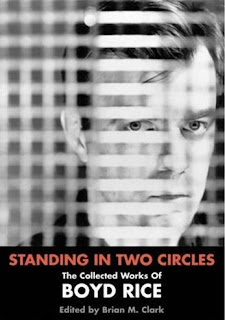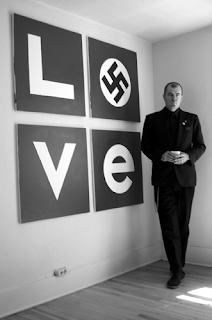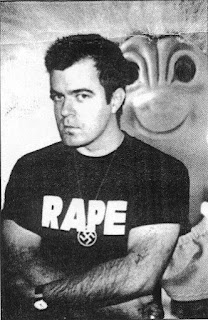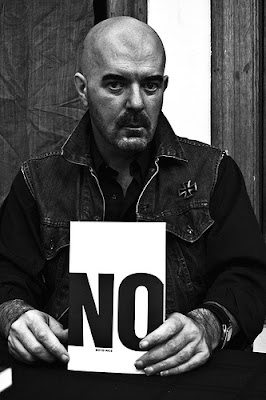“The Undying Appeal of White Nationalism”
Posted on January 4, 2015 by valdinoci
from the good comrades at Candles and Torches
Neofascism in the Cultural, Artistic, and Ecological Movements
The earth is firmly enveloped in crisis. This crisis is at once material and existential. The economy can no longer support the human weight that bends it at its foundation. Can not, or will not. The aftermath of the recession has produced only one reality: an intensified stratification of global society.
The crises have created a world devoid of meaning. Everywhere, people question the bold political narratives of the present, exposing them all as being without purpose. Democracy appears as the ridiculous theater that it always was.
In much of the world, young people found solace in the lack of meaning. They embraced cynicism and insincerity as responses to the real situation. As time went on, they found that this ironic perspective failed them in the very same way as did the dominant paradigm.
The recession of 2008 propelled the earth into a state of delirium. Over the following three years, the world fought to materially answer the existential crisis; to existentially answer the material. These popular movements posed a question. Is it even possible, in the 21st century, to imagine another way of living? All of society was exposed for its repressive essence, and people began to appropriate buildings, parks, universities, vacant lots, and city centers to begin directly creating a different way of life.
The question of the people fighting in occupied buildings and sleeping in city squares never received a response. Echoes, but not answers. The militants of 2011 reluctantly returned to life in the void.
We are still living with the same crisis. Meaning has yet to be restored. Around the world a new movement is emerging.
Across the globe, a reactionary wave has presented itself as the answer to the question posed six years ago. In Greece, Ukraine, Thailand, Venezuela, Russia, and Italy, neofascist parties have reemerged in the form of militant street-level uprisings. In the United States, fascist influences have begun to permeate the cultural, artistic, technological, and deep ecology movements.
In particular, the strong historical precedence of fascist influence on the legacy of ecological movements illuminates a need to take this situation seriously.
Ecology
Esoteric fascism is growing in the ecology movement. This is nothing new. The term “ecology” was coined by the racist, white nationalist, eugenics enamored German biologist Ernst Haeckel in the 19th century [1]. Haeckel founded the eugenicist and white nationalist Monist League in 1905 to propagate his racist views. Haeckel later joined the occultist Thule Society, a spiritual organization that sponsored and helped to develop the Nazi Party.
The German concept of “blut und boden” (blood and soil) traces its origins to the ethno-nationalist Volkisch movement. The belief insists that a people are connected to a historical territory, and that whites must protect the health of that land in order to ensure the continuity of the Aryan race.
Inspired by this view, German philosopher Rudolf Steiner founded Anthroposophy in 1912. Anthroposophy was a school of ethno-religious mysticism that promoted the idea of a race’s spiritual connection to a local environment along with the belief in a hierarchy of human races and the need to keep these races separate. These beliefs were heavily influential in the Volkisch movement of the 1920s.
The Wandervogel (wandering bird) youth movement was a strongly influential back-to-nature cultural force in Germany in the early 20th century centered around environmentalism, communal living, eastern religion, and staunch nationalism. Wandervogel youth believed political action to be incapable of correcting the deeply entrenched societal crisis, so they looked instead to personal and cultural transformation. The immigration of some Wandervogel youth to America in the early 20th century helped to inspire the Hippie movement [2]. Initially, the Wandervogel movement was comprised of people from somewhat disparate philosophical backgrounds, but by the 1930s most of the tendency was absorbed by the Nazi Party.
The Wandervogel subculture was a reflection of the larger The Lebensreform (life reform) movement. Lebensreform advocated organic diets, sexual liberation, vegetarianism, and a deep respect for nature. The tendency was popular in Switzerland and Germany in the early 20th century. Anarchists were very influential in the Lebensreform tendency, people like painter Karl Wilhelm Diefenbach and poet Gusto Graser promoted liberatory ideas among the movement. Graser, along with cultural libertines Henry Oedenkoven and Ida Hofmann, founded the Monte Verita commune in Switzerland in 1900. The commune initially existed as an experimentation in living according to communist ideals, promoting a way of living modeled after “primitive socialism”. Anarchists from around Europe flocked to Monte Verita. The communards were largely vegetarian, and practiced polyamory and held a deep respect for the environment.
By the 1930s, many of the anarchists of Monte Verita abandoned their long-held ethics and joined the Nazi Party [3].
The same trend occurred in the Lebensreform movement in general. Richard Ungewitter, a white nationalist pioneer of the German nudist movement and advocate of cultural upheaval, wrote and distributed white supremacist and anti semitic texts. He insisted that the seemingly emancipatory cultural trends of the time would be the way that the Aryan race would reestablish its dominance over “the diabolical Jews”. This reactionary tendency within the Lebensreform movement later inspired leaders of the Nazi Party.
The environmentalism of the Third Reich largely came from the mystical and anti-rational fascist lineage promoted by Richard Darre, Alfred Rosenberg, Rudolph Hess, and Heinrich Himmler [4]. It was Darre who introduced the blood and soil ideology to the NSDAP (Nazi party). As the Nazi movement was very dynamic in its early days, there was tension between the spiritualistic, anti-rational tendency and the cold, calculating, efficiently rational wing of the party.
Likewise, there was conflict between the ostensibly workerist and often openly gay wing of the movement (the Sturmabteilung, abbreviated as “SA”), and the rest of the NSDAP. The “blood purge” of the SA has become a focal point for some people in the current Neofolk subculture.
Music
The neofolk genre is loosely based around traditional european cultural heritage, practices, and music. Many of the bands that popularized the genre have current or past allegiances to fascist politics. Death in June, perhaps the best known name in the genre, is the project of third-reich obsessed musician Douglas Pearce. Pearce named the band in honor of the SA stormtroopers who were violently expelled from the Nazi Party in the Night of the Long Knives blood purge of 1934 [5].
Death in June has a history of collaboration with Boyd Rice, a somewhat more obtuse performer whose usage of third reich imagery is equally unironic. Rice appeared as an outspoken guest on the television show of Tom Metzger, founder of the well-known neo nazi group White Aryan Resistance. Rice has toured the US extensively with Cold Cave, an act founded by Wes Eisold. Eisold was a well known figure in the hardcore scene; his band American Nightmare was very popular in underground music scenes in the early 2000s.
Both Death in June and Boyd Rice have had several of their shows canceled due to pressure from anti-fascists over the past few years.
For the most part, bands in the neofolk and neo dark-wave scenes eschew overt fascist politics in favor of “apolitical” stances and a fixation on cultural heritage and “traditionalism”. Artists often state their insistence on playing “white” or “european” music that is free of “negro” influences such as rock and roll, jazz, or rhythm.
Stella Natura is a large neofolk music festival held in the Tahoe National Forest of Northern California featuring dozens of acts and hundreds of attendees. Though the promoter, Adam Torruella, claims the event is non-political, he has invited the white nationalist publisher Counter-Currents to table at the event [6].
Counter-Currents (which recently had its San Francisco office smashed up in a late night attack) primarily sells white supremacist literature from esoteric fascist authors such as Julius Evola and Savitri Devi. Devi, a Nazi sympathizer who served as a spy for the Axis Powers during WWII, was born in France, moved to India, converted to Hinduism, and was an animal rights activist and deep ecologist. She promoted the idea of the supremacy of the Aryan race and the need for whites to respect other “noble races” such as Indians, who were believed by the nazis to be the racial relatives of white Aryans.
The festival is sponsored by the Asatru Folk Assembly (AFA). Asatru is a pagan faith founded in the 1970s based on ancient Norse beliefs. Early on, there was a split in the Asatru movement around the issue of white nationalism. The universalists opposed racism, the tribalists focused on ethnic and cultural heritage, and the folkish tendency advocated an entirely racialized conception of Asatru . The AFA comes out of the folkish lineage, meaning that it is part of the white nationalist wing of Germanic Paganism.
The AFA provided security for the festival as the “Viking Brotherhood”; the original name of the organization. According to reports from concertgoers, the Viking Brotherhood roamed the perimeter with zip-ties on their hips while maintaining a diligent eye for anti-fascists.
The festival’s lineup has included several post-fascist acts and performers. Blood Axis, the band of neofascist author Michael Moynihan performed, as did Changes, a band founded by white nationalist Robert Taylor [7]. Fire and Ice and Waldteufel have also played the festival, both acts having ties to white nationalist movements. Neofascist bands Die Weisse Rose and Of the Wand and Moon were scheduled to perform in 2013 but could not enter the country due to visa issues.
This cultural tendency has grown among the hipster crowd, many of whom naively believe that the fascist aesthetic is merely ironic or just an added effect for shock-value. It has also grown among young white people from black metal and dark-wave scenes who feel alienated by the emptiness of modern society and desperately reach back to a romanticized and fictitious ancestral past.
Nihilism as Question and the Suppression of the Hipster
The epoch of the hipster has been marked by an irrepressible irony; a tangible insistence on the meaninglessness of things. The entire world appears to rotate without purpose; the era of metanarratives has long since passed and history seems to stand still. This tendency’s ascension coincides with a social era widely referred to as “liberal multiculturalism”. This multiculturalism is widely seen, by white people at least, as having reached a state of hegemonic dominion over all societal affairs. In this context, nothing can truly be racist, as the institutionalization of political correctness has seemingly relegated the older, more blatant forms of racism to the margins of culture and of society.
Because of this, the era of the hipster is not anti-racist, in fact it has no need to be. The ideology of the present era is better understood as post-racial; the apparent suppression of the old forms of prejudice have rendered white supremacy a phantom of the past only seen presently in the most anachronistic vestiges of white provincial society.
Racism is thus perceived as being powerless and therefore either innocuous or ironic. The hipster appreciation of Boyd Rice and Death in June is the result of the assumption that the resurgent fascist movement cannot possibly be sincere (as sincerity is impossible) and that, if by some far-fetched chance it were, it would be incapable of attaining meaning, as such overt racism cannot be a threat in a post-racial world.
In the world of pop culture and in the world of the anarchist, nihilism has firmly taken root. The rejection of all values, with the exception of the interests of the self, stems from a dissatisfaction with the meaninglessness of modern life. The hipster nihilist surrounds himself with accumulated symbols of irony, as sincerity has become impossible in a world without direction, and true meaning no longer exists. The anarchist nihilist maintains a steadfast refusal to participate in any political activity other than the occasional online cheering for the smashing of windows, as activism reeks of leftist naiveté and fails to comprehend its own pointlessness amid the magnitude of the present subsumption of the world.
Until now, nihilism has been addressed as a solution. But nihilism is a question. It is a passionless cry into an indifferent distance that continues to await an answer.
What will bring meaning to the world? What force can again restore a sense of purpose to those without direction? For many, reaching back toward the dirt-covered hands of long-buried ancestors has been a starting point. A normative vision of the past harkens back to a simpler era. Young people everywhere are again discovering religions and the languages of their ancestors. Many have begun to experiment with the assumed eating habits of someone’s distant ancestors, and are convinced that the paleo diet will bring them back in tune with what humans are supposed to eat in their natural state. On trendy shopping strips in America’s cities, artisan boutiques are again emerging. Micro-brewing and woodworking are regaining prominence. Experienced beard trimmers and butchers skilled in charcuterie are again making a living as men once did in a bygone past. Young men in Red Wings and work shirts revive the wardrobes of white men before their supposed systemic emasculation by liberal feminism; they appear identical to their grandfathers walking to work in those old segregated factories. Levi’s commercials speak proudly of pioneers and territorial expansion into both the wild west and into the untamed and pre-gentrified neighborhoods of America’s rust belt.
The neofolk movement is merely the avante garde wing of this diffuse and growing cultural tendency that longs for a romanticized and uncorrupted past.
Radical Traditionalism, Revolutionary Reactionism
Presently, the mystical current of racist ecology is slowly gaining traction among some circles of former anarchists. Most notable is Olympia, Washington, where two former Green Scare prisoners and ex-anarchists have turned to white nationalism, citing a desire for white-only spaces, a respect for neo-nazis, and a pronounced disdain for “the Mexicans”. Nathan “Exile” Block and Joyanna “Sadie” Zacher were heavily influential in the green anarchist tendency prior to and during their incarceration for late-night arson attacks against industries responsible for massive environmental degradation. Disconcertingly, these two influential former Earth Liberation Front militants were initiated into the world of political violence while running through the streets of downtown Seattle in the anti-WTO Black Bloc in 1999 [8]. Several other people associated with the green anarchist movement in Olympia have followed their reactionary trajectory.
The quasi-spiritual works of ego-fascist Julius Evola and the “esoteric hitlerism” of white supremacist author Miguel Serrano [9] have been heavily influential in this growing circle. A webpage [10] operated by Nathan Block appears as a cascading scroll of imagery adorned with swastikas, black suns, and Anglo-Saxon runes complimented by an assortment of quotations from obscure neofascist theorists. This cult-like formation has expressed a sincere admiration for would-be race war instigator Charles Manson [11], particularly his environmental decree “ATWA” which stands for “air trees water animals” or “all the way alive” (the latter was used as the title of a 2012 public statement from Zacher published in the Earth First Journal). A 2007 communique written by Block and Zacher makes several vague references to the need to continue the ecological struggle in the name of the white race (often hidden behind double meanings) before concluding with an allusion to Manson’s environmental decree.[A]nd let those of us who heed the calls so often ignored stand upright, with clear vision, whether illuminated by the great Sun or by a more obscure Light, which rides with the night terror with all creatures of the hidden hours: the clawed, the winged, the hoofed, and also with those beings referred to by the euphemisms of ‘the ancestors’, ‘the fair folk’, or indeed, the ‘elves’.
air trees water animals [12]
As with the Apoliteia tendency (explained below) and the Wandervogel movement, they claim an aversion to the political and a focus on individual and cultural pursuits such as touring in Neofolk bands and practicing Germanic pagan rituals.
Unfortunately, many green anarchists do not fully understand this resurgent white nationalism. Many assume that any apparent fascist sympathies must be purely aesthetic or symbolic. This willful ignorance will likely allow the trend to continue to grow, particularly in the white counter cultural enclaves of the Pacific North West.
Continues at: https://nycantifa.wordpress.com/2015/01 ... tionalism/





